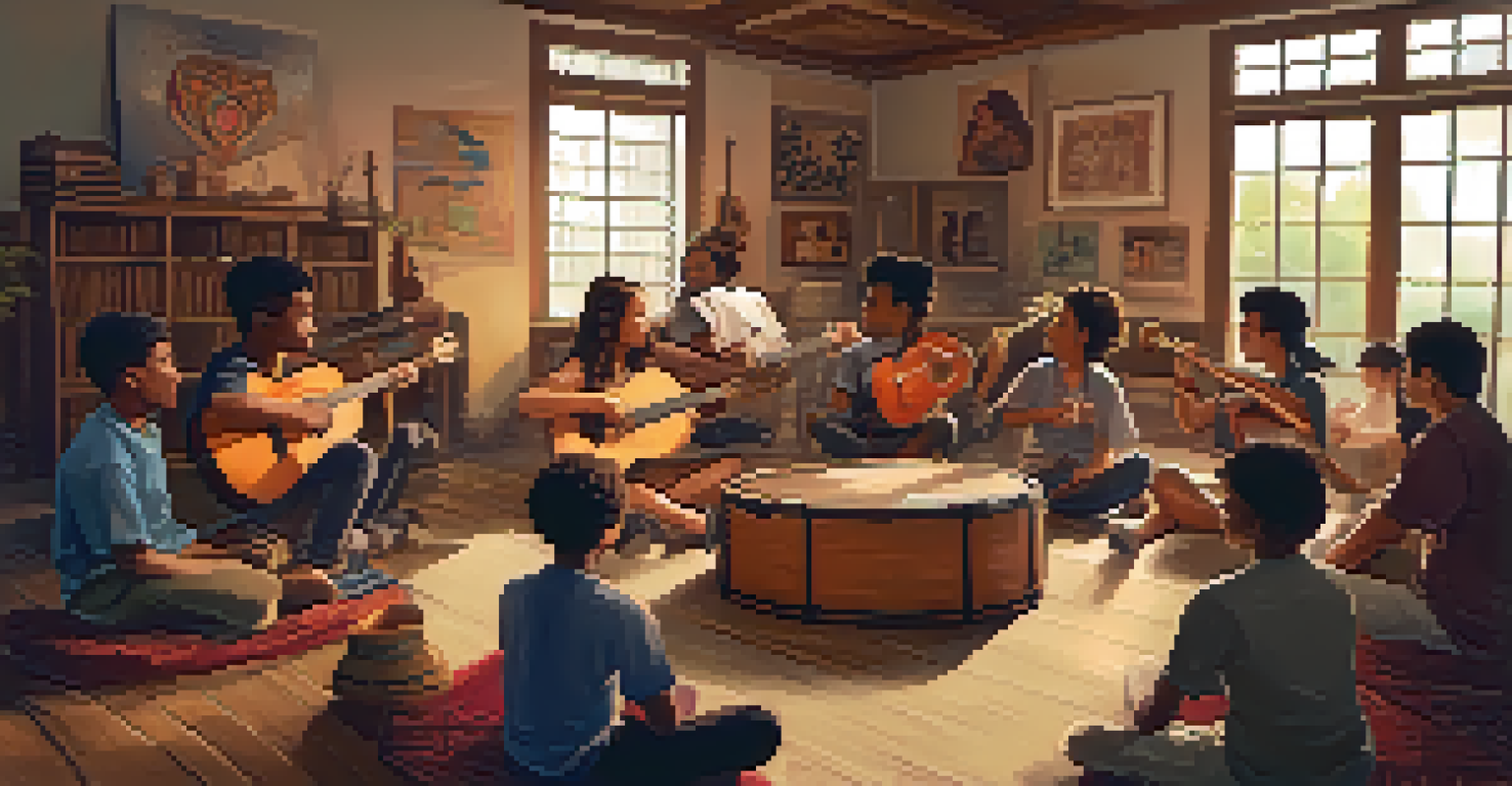Collaborative Music Projects: Building Peace Through Art

The Power of Music in Promoting Peace
Music has a unique ability to transcend boundaries and connect people. Through shared rhythms and melodies, individuals from diverse backgrounds can come together, fostering understanding and empathy. This form of expression is not just entertainment; it's a powerful tool for dialogue and healing.
Music can change the world because it can change people.
For example, the Global Music Project brings together artists from conflict zones to create music that reflects their experiences. These collaborations allow participants to share their stories, creating a rich tapestry of sound that promotes mutual respect and peace. In essence, music becomes a universal language that speaks to our shared humanity.
By harnessing the emotional depth of music, these projects can facilitate discussions about difficult topics, such as war and displacement. They create safe spaces where individuals can express their feelings and experiences, paving the way for reconciliation and unity.
Successful Collaborative Music Projects Around the World
Various collaborative music projects have emerged globally, each with its unique focus and impact. One notable example is 'Playing for Change,' an initiative that connects musicians worldwide to create songs that promote peace and social change. Their videos showcase the beauty of collaboration and the shared human experience, inspiring millions.

Another remarkable project is 'Songs for Peace,' which gathers artists from different conflict regions to compose music together. This initiative not only allows them to share their stories but also creates a powerful message of hope that resonates with listeners across the globe. By working together, these musicians highlight the potential for harmony despite differences.
Music Bridges Cultural Divides
Collaborative music projects unite diverse artists, fostering empathy and understanding through shared musical experiences.
Such projects illustrate how music can act as a bridge between cultures, breaking down barriers and building connections. They also remind us that, regardless of our backgrounds, we can come together for a common cause: peace.
The Role of Technology in Collaborative Music
In today's digital age, technology plays a crucial role in facilitating collaborative music projects. Online platforms allow artists from around the world to connect and create music together, regardless of geographical constraints. This accessibility has opened up new possibilities for collaboration and creativity.
Where words fail, music speaks.
For instance, software like Soundtrap enables musicians to record and edit songs in real-time, making it easy for participants to contribute from different locations. This not only enhances the creative process but also makes it more inclusive, allowing artists from varied backgrounds to share their perspectives.
Moreover, social media has become a powerful tool for promoting these projects, helping to spread their messages far and wide. By sharing their music online, these artists can reach audiences who might not otherwise be exposed to their stories, further amplifying the impact of their collaborative efforts.
Healing Through Music: Personal Stories
Many individuals involved in collaborative music projects share transformative personal stories that highlight the healing power of art. For instance, a musician from a war-torn region may find solace in creating music with others who have experienced similar traumas. This shared experience can foster a sense of community and understanding that transcends pain.
One powerful anecdote is that of a young artist who participated in a cross-cultural music project after fleeing conflict. Through songwriting and collaboration, they not only found a creative outlet but also a supportive network of fellow musicians who understood their struggles. This connection helped them heal and rebuild their life in a new environment.
Technology Enhances Music Collaboration
Digital platforms and social media empower musicians worldwide to connect and create together, amplifying their messages of peace.
These narratives demonstrate that music can serve as a therapeutic tool, allowing individuals to process their emotions and experiences. By sharing their stories through song, participants can find empowerment and hope, inspiring others to do the same.
Education and Engagement in Music Projects
Collaborative music projects often emphasize education and engagement, particularly for young people. By involving students in these initiatives, organizers can teach valuable skills, such as teamwork, communication, and cultural appreciation. This not only enriches their musical abilities but also fosters a sense of global citizenship.
For example, programs like 'Music for Peace' invite youth from various backgrounds to collaborate on original compositions. Through workshops and mentorship, participants learn about each other's cultures while expressing themselves creatively. This hands-on experience encourages empathy and understanding among participants.
By investing in education through music, these projects empower the next generation to become advocates for peace. They help young people recognize the importance of collaboration and dialogue in addressing global challenges, paving the way for a more harmonious future.
Challenges Faced in Collaborative Music Projects
While collaborative music projects are powerful tools for promoting peace, they also face various challenges. One significant issue is the logistical complexity of coordinating participants from different regions, especially in areas affected by conflict. Navigating these obstacles requires careful planning and strong communication.
Another challenge is ensuring that all voices are heard and represented in the creative process. Sometimes, power dynamics can emerge, leading to certain perspectives being overshadowed. It's crucial for organizers to foster an inclusive environment where every participant feels valued and able to contribute.
Music as a Healing Tool
Personal stories from participants highlight how collaborative music projects provide emotional healing and a sense of community.
Despite these challenges, many projects find innovative solutions to overcome obstacles. By prioritizing collaboration and understanding, they can create meaningful experiences that resonate with both participants and audiences.
The Future of Collaborative Music for Peace
As the world continues to face various challenges, the future of collaborative music projects looks promising. With advancements in technology and an increasing awareness of the importance of cultural exchange, these initiatives are likely to grow and evolve. Artists and organizations are coming together to explore new ways of fostering peace through music.
One exciting possibility is the rise of virtual collaborations, enabling musicians from different continents to create together without the need for physical travel. This not only saves resources but also allows for more diverse participation, enriching the collaborative experience.

Ultimately, the future of collaborative music for peace hinges on our collective commitment to unity and understanding. By supporting these projects and sharing their messages, we can all play a part in building a more harmonious world through the universal language of music.